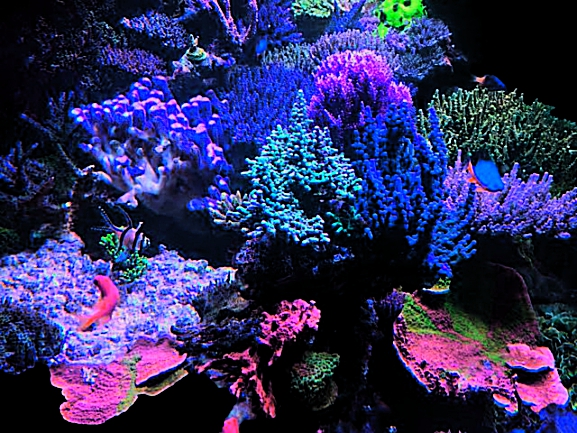I want to be clear that the parameters I maintain are not necessarily what you should aim for, as every tank is unique.
You have to decide which parameters to target. A good practice is to base your targets on the parameters of your chosen salt mix.
The reason for this is to avoid causing parameter swings during your weekly, bi-weekly, or monthly water changes.
Matching your tank’s parameters to your salt mix is crucial for stability.
Why Do I Run Elevated Alkalinity, Calcium, and Magnesium?
In my Red Sea Max Nano, I use Red Sea’s Coral Pro salt.
I have found that small coral fragments, particularly SPS corals, tend to fare better and establish themselves more successfully with slightly elevated parameters.
Therefore, I have matched my dosing system to maintain the main elements—alkalinity, calcium, and magnesium—at these higher levels, consistent with the salt mix.
I maintain an alkalinity of around 12 degrees of Carbonate Hardness.
My calcium is kept between 470 and 500, and magnesium stays between 1480 and 1500.
My salt mix produces these levels during a water change, which is why I have programmed my doser to sustain them.
How Important is Regular Water Testing?
The only way to truly know your water parameters is through consistent testing. I cannot overstate the importance of testing frequently.
Without it, you are simply guessing, which can lead to fluctuating parameters and a subsequent loss of coral color and health.
What Are My Current Tank Parameters?
At present, my tank’s alkalinity is at 12, calcium is at 500, and magnesium is at 1500. Regarding my nutrients, I monitor nitrate and phosphate.
I maintain my nitrate level between 0.2 and 3 parts per million; it is currently at 2.5 parts per million.
How Do I Measure and Manage Phosphate?
I try to keep my phosphate levels as low as possible without reaching zero. Currently, I use Salifert test kits for my measurements.
A drawback of the Salifert phosphate kit is its tendency to show a result of zero even when trace amounts of phosphate are present, making it less accurate for precise readings.
For a truly accurate number, I would highly recommend using a Hanna checker.
My Salifert test consistently reads zero. If my test were to ever show a blue tint, which has not happened with my tank, I would know it is time to take action.
What Temperature and Salinity Do I Maintain?
Of course, temperature can be maintained anywhere between 25 and 26 degrees Celsius, as long as it remains stable.
I keep my tank at a constant 25.5 degrees. For salinity, I maintain a level of 35 parts per thousand.
What is the Key to a Successful Maintenance Routine?
Every reef tank is different, and there is no single right or wrong way to manage one.
The true skill in reef-keeping lies in being attuned to the tank’s evolving needs and adjusting your maintenance routine accordingly.
As the tank matures and its corals grow, you must adapt your methods to maintain a stable environment.
Why is Stability More Important Than Specific Numbers?
As many hobbyists know, stability is the most critical factor. The specific numbers are less important than their consistency.
For example, I have known people who have great success with an alkalinity as low as 5 degrees of Carbonate Hardness simply because that level was held constant.
The core message regarding reef parameters is to maintain stability above all else.
Avoid making sudden, drastic changes. Instead, pick your target numbers, commit to them, and focus on maintaining them.
How Do I Adapt My Routine to the Tank’s Needs?
In terms of maintenance, my approach involves making small adjustments based on the tank’s parameters and needs.
As my aquarium has evolved, I have become more attuned to its condition, which is essential.
It has been about a month since my last water change, and I have also been running the system for nearly a month without a filter sock. I am closely monitoring the nutrients.
My nitrates are at 2.5 parts per million, and the phosphate test kit shows a reading of zero.
I assume a trace amount of phosphate is likely present in the system, so I consider these to be good nutrient levels.
What Is My Water Change Strategy?
If my nutrient levels increase any further, I will perform a large water change. I will likely need to do one in the next week or two, especially if the nitrate level reaches 3 parts per million.
At that point, I will conduct an 85% water change to reset the system.
A benefit of such a large change is that it significantly reduces nitrates while aligning all parameters with my fresh salt mix.
More importantly, it replenishes all the trace elements—the ones we do not test for and whose levels are unknown.
I also supplement with Red Sea’s A, B, C, and D color additives for an extra boost. After the change, the nutrients will be greatly reduced, with nitrate possibly dropping to 0.5 parts per million.
I then gradually increase feedings to bring the nutrient levels back up.
How Do You Know When Your Changes Are Working?
The process is a continuous cycle of testing. I encourage you not to adopt my parameters as your own, but to pick a target and maintain it, observing how your tank responds.
In my experience, it takes at least one to three weeks to see any noticeable difference after making an adjustment.
I recommend making small changes and then patiently observing the outcome.
What Is My Current Filtration Setup?
The parameter and maintenance routine for my aquarium is very simple. Now at nine months old, it is maturing well, and everything is thriving—growth is good, and coloration is vibrant.
I have removed the filter sock, so there is no mechanical filtration in my system. The water is circulated by the protein skimmer, which I clean once a week.
I am not using any Granular Ferric Oxide, Rowaphos, or other phosphate-removing media.
My only chemical filtration is a small bag, about a shot glass worth, of Red Sea Reef Spec Carbon, which I change every one or two months. My routine maintenance is minimal.
Aside from cleaning the glass, ensuring the skimmer is cleaned weekly, and consistently testing and adjusting the doser to keep my parameters stable, there is very little else to do.
Conclusion
To avoid fluctuations during water changes, I match my tank’s parameters closely to the salt mix I use.
Stability is my top priority, so I maintain slightly elevated levels: alkalinity at 12 °KH, calcium between 470 and 500 parts per million, and magnesium between 1 480 and 1 500 parts per million, as provided by the mix I have chosen.
I test my water weekly using reliable kits. For phosphate, I use a Hanna checker. I keep nitrate between 0.2 and 3 parts per million and ensure phosphate remains just above zero.
I hold the temperature steady at 25.5 °C and salinity at 35 parts per thousand.
When nitrate levels approach 3 parts per million, I perform a large water change of approximately 85 percent. This helps reset all parameters and replenish trace elements.
I make adjustments gradually, allowing 1 to 3 weeks to monitor results and confirm that my reef continues to thrive.

My name is Chibuzor Abraham Mba, and I’m the aquarist behind this website. I’ve spent years exploring the fascinating world of aquariums—especially small-scale tanks like nano and pico setups. Over time, I’ve made my fair share of mistakes, and through each one, I’ve learned valuable lessons.
